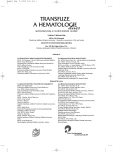Sekce v angličtině
Vyšlo v časopise:
Transfuze Hematol. dnes,15, 2009, No. 3 - Supplementum, p. 28.
032
PLATELET ADDITIVE SOLUTION - ENHANCED SAFETY AND USABILITY OF TRANSFUZED PLATELET CONCENTRATES
Nussbaumer W.
Innsbruck
Whereas viral infectious risks (HIV, HBV and HCV) of platelet transfusions are nearly negligible today, remaining side effects of platelet transfusions like allergic reactions (AR), febrile (FNHTR) or non febrile non hemolytic transfusion reactions (NFNHTR) as well as bacterial contamination of the platelet concentrate still exists. To overcome these problems the use of platelet additive solutions (PAS) could be of help. Dilution of the produced platelet concentrate with PAS by 66% can reduce the protein content of the unit significantly, dilute therefore the ABO antibody to a level of no harm for the recipient, reduces the risk of allergic side effects and may help to improve the acceptance of the unit by the recipient. Additionally, the usage of PAS is mandatory for nearly all pathogen inactivation methods and reduces the plasma loss of the donor. We decided in 2007 to use PAS for all our produced platelet concentrates and started that policy with 2008. We produce single donor platelets exclusively and 50 % of our platelets are produced on Amicus (Fenwal, Round Zurich, IL, USA) with T-Sol and 50 % were produced with Trima (Caridian, Denver, USA) with SSP+ (Macopharma, Langen, Germany). For both methods, the dilution was 1:3, plasma versus PAS. With consideration of the above mentioned side effects we analyzed all transfused units in 2008 (n= 3979) and compared them with the transfused units from 2004 (n= 3763), a year all units were produced in 100% plasma. In the past platelets for recipients with repeated side effects during previous transfusions, were washed. Therefore the number of washed units could be a valuable predictor for the acceptance of the platelet units. The number of washed units could be reduced by 86%, which means 117 washed units in 2008 vs. 832 washed units in 2004. Total registered side effects could be reduced from 33 to 17 (2004 vs. 2008, p = < 0,05). Splitting all side effects to AR, FNHTR and NFNHTR the reduction of the registered events was remarkable for AR (25 vs. 5, 2004 vs. 2008, respectively) and FNHTR (32 vs. 6, 2004 vs. 2008, respectively) whereas the frequency of FNHTR could not be significantly influenced by the use of PAS derived platelets (8 vs. 7, 2004 vs. 2008, respectively). From the analyzed units 351 were transfused mayor incompatible (ABO antibody of the recipient against antigens of the donor), 394 minor incompatible (ABO antibodies in the unit against antigens of the recipient) and 18 mixed incompatible without any registered increase of side effects.
Our data demonstrate a positive effect of the use of PAS on the acceptance of platelet units by the recipients with respect to ABO incompatibility, AR and NFNHTR whereas the number of FNHTR could not be influenced. Especially the acceptance of not ABO matched platelets could simplify the platelet supply for donation services, particularly during weekend and holiday seasons. However, clinical data about the efficacy of PAS derived platelet units, in addition to published data, have to complete our data in the future.
Štítky
Hematologie a transfuzní lékařství Interní lékařství OnkologieČlánek vyšel v časopise
Transfuze a hematologie dnes

2009 Číslo 3 - Supplementum
- MINISERIÁL: Když ženám stoupá tlak...
- Není statin jako statin aneb praktický přehled rozdílů jednotlivých molekul
- Specifika v komunikaci s pacienty s ránou – laická doporučení
- Když ženám stoupá tlak... aneb jak hypertenze zasahuje i do oblastí, kde to nečekáme (3. díl − komentář z praxe)
- Endotel jako společná oběť hypertenze a dyslipidémie
Nejčtenější v tomto čísle
- Krví přenosné choroby
- Hemoterapie
- Výroba transfuzních přípravků, kontrola jakosti
- Transfuzní služba - historie a současnost
